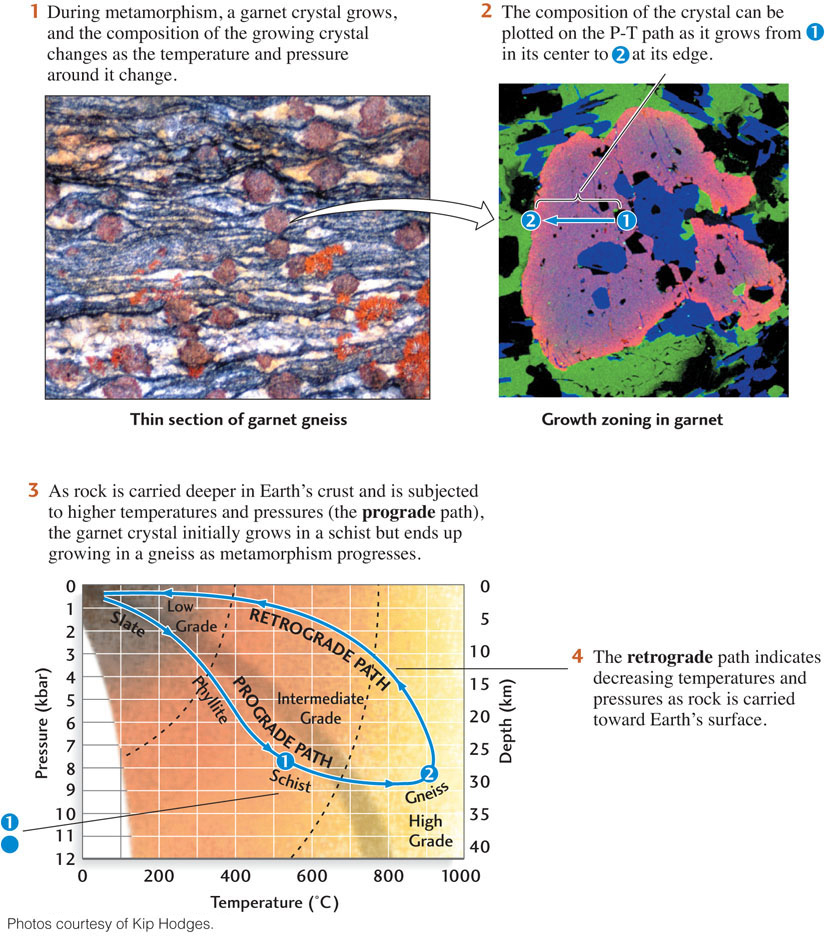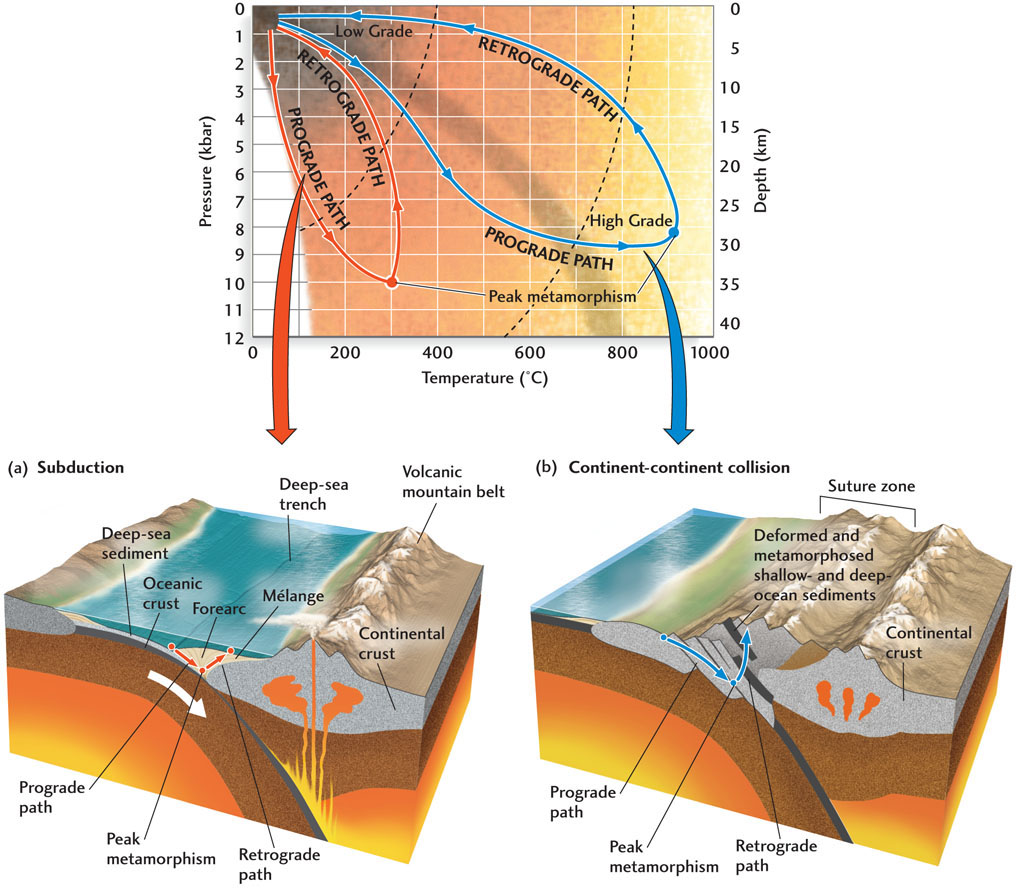Plate Tectonics and Metamorphism
Soon after the theory of plate tectonics was proposed, geologists started to see how patterns of metamorphism fit into the larger framework of plate movements. Different types of metamorphism are likely to occur in different plate tectonic settings (see Figure 6.4):
 Continental interiors. Contact metamorphism, burial metamorphism, and perhaps regional metamorphism occur at different levels in the crust. Shock metamorphism is likely to be best preserved in continental interiors because their large areal extent provides a large target area to record rare meteorite impact events.
Continental interiors. Contact metamorphism, burial metamorphism, and perhaps regional metamorphism occur at different levels in the crust. Shock metamorphism is likely to be best preserved in continental interiors because their large areal extent provides a large target area to record rare meteorite impact events. Divergent plate boundaries. Seafloor metamorphism and contact metamorphism around plutons intruding into the oceanic crust occur at divergent plate boundaries.
Divergent plate boundaries. Seafloor metamorphism and contact metamorphism around plutons intruding into the oceanic crust occur at divergent plate boundaries. Convergent plate boundaries. Regional metamorphism, high-pressure and ultra-high-pressure metamorphism, and contact metamorphism.
Convergent plate boundaries. Regional metamorphism, high-pressure and ultra-high-pressure metamorphism, and contact metamorphism. Transform faults. In oceanic settings, seafloor metamorphism may occur. In both oceanic and continental settings, we find extensive metamorphism caused by shearing forces along transform faults.
Transform faults. In oceanic settings, seafloor metamorphism may occur. In both oceanic and continental settings, we find extensive metamorphism caused by shearing forces along transform faults.
Metamorphic Pressure-Temperature Paths
As we have seen, the concept of metamorphic grade can inform us of the maximum pressure or temperature to which a metamorphic rock has been subjected, but it tells us nothing about where the rock encountered those conditions. Nor does it tell us anything about how the rock was exhumed, or transported back to Earth’s surface.
Each metamorphic rock has a distinctive history of changing temperature and pressure that is reflected in its texture and mineralogy. This history is called a metamorphic pressure-temperature path, or P-T path. The P-T path can be a sensitive recorder of many important factors that influence metamorphism—such as sources of heat, which changes temperatures, and rates of tectonic transport (burial and exhumation), which changes pressures. Thus, P-T paths are characteristic of particular plate tectonic settings.
To obtain a P-T path, geologists must analyze specific minerals from metamorphic rock samples in the laboratory. One of the minerals most widely used for this purpose is garnet, a common porphyroblast that serves as a sort of P-T path recording device (Figure 6.12). Garnet crystals grow steadily during metamorphism, and as the pressure and temperature of the environment change, the chemical composition of the garnet changes. The oldest part of a garnet crystal is its core, and the youngest is its outer edge, so the variation in its composition from core to edge will yield the history of the metamorphic conditions under which it formed. Geologists can measure the chemical composition of a garnet porphyroblast in the laboratory and plot the corresponding pressure and temperature values as a P-T path (see Practicing Geology).

163
P-T paths have two segments: a prograde segment that indicates increasing pressure and temperature, and a retrograde segment that indicates decreasing pressure and temperature. The P-T paths of some rock assemblages that form at convergent boundaries are shown in Figure 6.13.

Ocean-Continent Convergence
A distinct metamorphic assemblage forms when oceanic lithosphere is subducted beneath a plate carrying a continent on its leading edge (Figure 6.13a). Thick sediments eroded from the continent rapidly fill the deep-sea trench that forms a flexural basin at the subduction zone. As it descends, the oceanic lithosphere stuffs the region below the inner wall of the trench (the wall closer to the continent) with these sediments, as well as with shreds of ophiolite suites scraped off the descending plate. The result is a chaotic mix known as a mélange (French for “mixture”). Assemblages of this type, located in the forearc region of a subduction zone—the area between the deep-sea trench and the volcanic mountain belt—are enormously complex and variable. The rocks formed there are all highly folded, intricately faulted, and metamorphosed (Figure 6.14). They are difficult to map in detail, but are recognizable by their distinctive combination of minerals and structural features.

164
Subduction-Related Metamorphism
Blueschist—the metamorphic rock type whose minerals indicate that they were produced under high pressures but at relatively low temperatures (see Figure 6.9b)—forms from mélange in the forearc region of a subduction zone. Here, materials may be carried rapidly into the subduction zone to depths as great as 30 km. The cool subducting slab moves downward so quickly that there is little time for it to heat up, but pressure on the slab increases rapidly.
Eventually, as part of the subduction process, the material rises back to the surface. This exhumation results from two forces: buoyancy and circulation. Imagine trying to push a basketball below the surface of a swimming pool. The air-filled basketball has a lower density than the surrounding water, so it tends to rise back to the surface. In a similar way, the subducted metamorphic rocks are driven upward by their inherent buoyancy relative to the denser crust that surrounds them. But what “pushes” the material down to begin with? A natural circulation pattern is set up in the subduction zone. You can think of a subduction zone as an eggbeater. As the eggbeater rotates, it moves the froth in a circular direction. What moves in one direction eventually moves in the opposite direction because of the circular motion. In an analogous way, the sinking slab in a subduction zone sets up a circular motion of material above the slab, first pulling it down to great depths, then returning it to the surface.
Figure 6.13a shows the typical P-T path of rocks subjected to blueschist-grade metamorphism during subduction and exhumation. Note that the P-T path forms a loop in this diagram. If we compare the graph in Figure 6.13a with the metamorphic facies diagram in Figure 6.11, we can see that the prograde segment of the path represents subduction, as shown by a rapid increase in pressure and only a relatively small increase in temperature. During exhumation, the path loops back around because temperature is still slowly increasing, but now pressure is rapidly decreasing. The retrograde segment of the P-T path represents the exhumation process described above.
165
Evidence of Ancient Ocean-Continent Convergence
The essential elements of these subduction-related rock assemblages have been found at many places in the geologic record, particularly around the Pacific Ocean basin. One can see mélange in the Franciscan formation of the California Coast Ranges and in the parallel volcanic mountain belt in the Sierra Nevada to the east. These rocks mark the Mesozoic collision between the North American Plate and the Farallon Plate, which has nearly disappeared by subduction (see Figure 10.6). The location of mélange to the west and a volcanic mountain belt to the east shows that the Farallon Plate to the west was the subducted one. Analysis of the P-T paths of metamorphic minerals in the blueschist-grade Franciscan mélange reveals a loop similar to that shown in Figure 6.13a, indicating a rapid increase in pressure, which is characteristic of subduction.
Continent-Continent Collision
Because continental crust is buoyant, when a continent collides with another continent, both continents resist subduction and stay afloat on the mantle. As a result, a wide zone of intense deformation develops at the convergent boundary where the continents grind together. The remnant of such a boundary left behind in the geologic record is called a suture. The intense deformation results in a much-thickened continental crust in the collision zone, often producing high mountains. Ophiolite suites are often found near the suture.
As the lithosphere thickens, the deep parts of the continental crust heat up and undergo varying grades of metamorphism. In still deeper zones, melting may begin at the same time, forming magma chambers deep within the core of the mountain range. In this way, a complex mixture of metamorphic and igneous rock forms the core of the mountain belt. Millions of years afterward, when erosion has stripped off the surface layers of the mountains, their cores, containing schists, gneisses, and other metamorphic rocks, are exposed, providing a rock record of the metamorphic processes that formed them.
P-T paths of metamorphic rocks produced by continent-continent collision have a different shape from those of rocks produced by subduction alone. Continent-continent collision generates higher temperatures than subduction; therefore, as rock is pushed to greater depths, the temperature that corresponds to a given pressure will be higher (Figure 6.13b). The P-T path begins at the same place as the path for subduction, but shows a more rapid increase in temperature as greater pressures and depths are reached. Geologists generally interpret the prograde segment of a P-T path with this shape as indicating the burial of rocks beneath high mountains. The retrograde segment represents uplift and exhumation of the buried rocks during the collapse of mountains, either by erosion or by postcollision stretching and thinning of the continental crust.
The prime example of a continent-continent collision zone is the Himalaya, which began to form some 50 million years ago when the Indian continent collided with the Asian continent. That collision continues today: India is moving into Asia at a rate of a few centimeters per year, and the mountain building is still going on, together with faulting and very rapid erosion by rivers and glaciers.
166
Exhumation: A Link Between the Plate Tectonic and Climate Systems
Forty years ago, plate tectonic theory provided a ready explanation for how metamorphic rocks could be produced by seafloor spreading, subduction, and continent-continent collision. By the mid-1980s, the study of PT paths provided a clearer picture of the specific tectonic mechanisms involved in the deep burial and metamorphism of rocks. At the same time, it surprised geologists by providing an equally clear picture of the subsequent, and often very rapid, uplift and exhumation of these deeply buried rocks. Since the time of this discovery, geologists have been searching for exclusively tectonic mechanisms that could bring these rocks back to Earth’s surface so quickly.
One popular idea is that mountains, having been built to great elevations during collisional crustal thickening, suddenly fail by gravitational collapse. The old saying “what goes up must go down” applies here, but with surprisingly fast results—so fast, in fact, that some geologists don’t believe gravity is the only important mechanism involved. Other forces must also be at work.
As we will learn in Chapter 22, geologists who study landscapes have discovered that extremely high erosion rates can be produced by glaciers and streams in tectonically active mountainous regions. Over the past decade, these geologists have presented a new hypothesis that links rapid rates of uplift and exhumation to rapid erosion rates. The idea is that the climate system, not tectonic processes alone, drives the movement of rocks from the deep crust to the shallow crust through the process of rapid erosion. Thus, plate tectonic processes—which act through mountain building—and climate processes—which act through weathering and erosion—interact to control the flow of metamorphic rocks to Earth’s surface. After decades of emphasis solely on plate tectonic explanations for regional and global geologic processes, it now seems that two apparently unrelated processes—metamorphism and erosion—are linked in an elegant way. As one geologist exclaimed: “Savor the irony should the metamorphic muscles that push mountains to the sky be driven by the pitter-patter of tiny raindrops.”